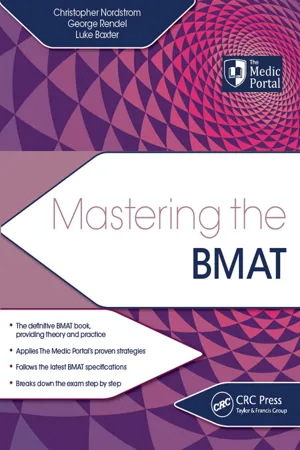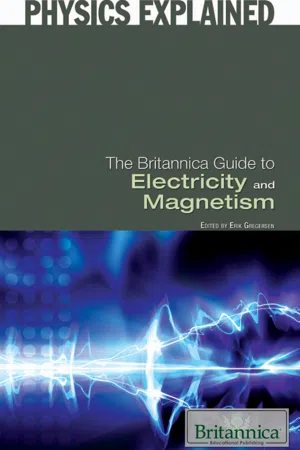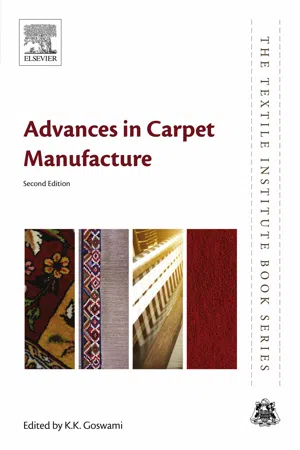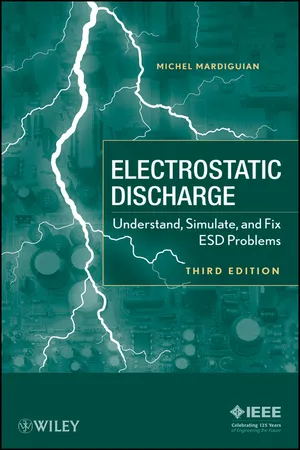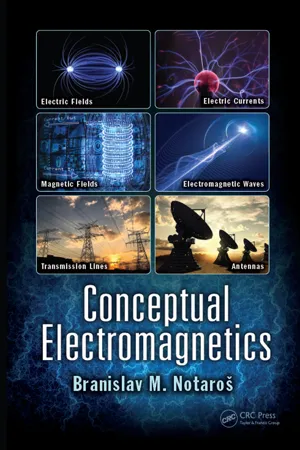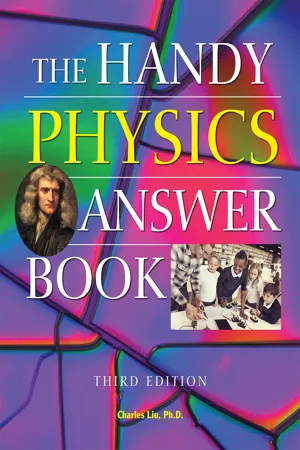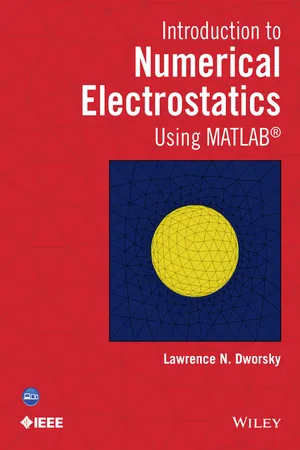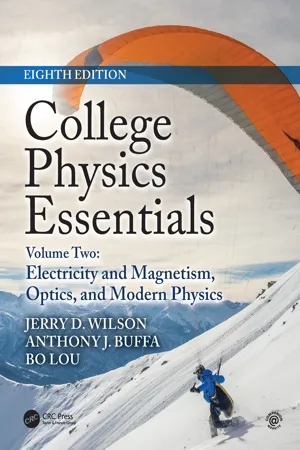Physics
Static Electricity
Static electricity is the build-up of electric charge on the surface of an object. It occurs when certain materials are rubbed together, causing electrons to be transferred from one material to the other. This imbalance of electric charge creates an electric field and can result in sparks or the attraction of small objects.
Written by Perlego with AI-assistance
Related key terms
Related key terms
1 of 4
Related key terms
1 of 3
12 Key excerpts on "Static Electricity"
- eBook - ePub
- Samarendra Kumar Biswas, Umesh Mathur, Swapan Kumar Hazra(Authors)
- 2021(Publication Date)
- CRC Press(Publisher)
The process of electrification (e.g., by rubbing glass with silk) is caused by the movement of electrons. In an uncharged body, atoms are electrically neutral, i.e., the total negative charge on the electrons is equal to the total positive charge on the atomic nuclei. Electrons are free to move, for example, during rubbing or when a body is placed in an electric field. An excess of electrons in a body, relative to its neutral state, means that the body is negatively charged. Similarly, a deficit of electrons relative to a neutral state means that the body is positively charged. The magnitude of the charge is expressed in coulombs (C).When the properties of flowing (current) electricity were discovered, the term static came into use to distinguish an electric charge that was at rest from one that was in motion. Today the term Static Electricity is used to describe phenomena from an electric charge, regardless of whether the charge is at rest or in motion.3 Streaming current or charging current (expressed in amperes) is defined as the flow rate of charge into a given system per unit of time. It is the current caused by the rate of flow of charged material into a system; it should be distinguished from the rate of static charge generation within a batch system, such as during the rubbing of solids or stirring of liquids.Static Electricity involves high potentials, generally of the order of kilovolts, and very low currents, generally in the range of milliamperes (mA). Therefore, Static Electricity effects are associated with an electric field, but unlike current electricity, Static Electricity has no significant magnetic field effects.Earth is a near-infinite “reservoir” of electrons and is conventionally referred to as having zero potential. Therefore, if a charged conductor is electrically connected to the earth, its potential becomes zero. Earthing also removes all charge from a conductor unless there is another charged body in its vicinity that influences by induction.Bodies with unlike charges attract each other, and those with like charges repel. Based on Coulomb’s law, if two bodies (that are small compared to the distance between them), having charges Q 1 and Q 2 coulombs, are placed in vacuum at a distance of r (m) between them, then the force F - eBook - ePub
- Christopher Nordstrom, George Rendel, Luke Baxter(Authors)
- 2016(Publication Date)
- CRC Press(Publisher)
Physics 1. Electricity 1.1 ElectrostaticsA material may be an electrical conductor, in which case it will easily disperse any electrical charge that it gathers. Other materials may be electrical insulators that do not disperse charge easily.If an insulator is rubbed it may become positively charged by losing electrons, or it may become negatively charged by gaining electrons. Friction causes the displacement of electrons.For instance, an acetate rod that is rubbed with a duster will lose electrons to the duster and become positively charged. A polythene rod that is rubbed with a duster will acquire electrons and become negatively charged (the duster will be positively charged).Charged objects with the same charge will be repelled from each other. Objects with different charges will be attracted to each other.Static Electricity is useful in some cases in industry, e.g. it can be used in spray painting. The object that needs to be painted is given a particular charge, and the paint droplets are given the opposite charge as they are released. This means the paint is attracted to the object and less is wasted.Static Electricity also poses a danger in some cases. Build-ups of charge may eventually be dissipated in the form of a spark. In certain scenarios, such a spark may ignite a fire. Hence certain precautions need to be taken, for instance, with vehicles that are used to transport flammable substances. Any charge that is built up as the vehicle travels needs to be discharged using an earth wire – this reduces the chance of a spark igniting a fire.1.2 Electric currentCurrent (I) is the flow of charge (usually electrons, although currents can be carried by other charged particles such as ions) through an electrical conductor. Its unit is the ampere (A) - eBook - ePub
- Richard A. Scott(Author)
- 2005(Publication Date)
- Woodhead Publishing(Publisher)
18Electrostatic protection
J A GONZALEZ, University of Alberta, CanadaPublisher Summary
The term “electrostatic” or “Static Electricity” refers to the phenomenon associated with the buildup of electrical charges generated, for example, by contact and/or rubbing of two objects. Static Electricity is generated by unbalancing the molecular configuration of relatively non-conductive materials. The major concern with Static Electricity is that Electrostatic Discharges (ESD) have proven to be a significant ignition source for flammable gases, vapors, or powders that may be present in certain industrial environments, resulting in fires and explosions and the possible loss of human life. Considerable research has been carried out on the charge generation and dissipation characteristics of textiles used in clothing. However, several issues remain unanswered and the industry is still in need of test methods that can strongly correlate with real-life conditions. For materials that are poor conductors of electricity, as are most textiles and polymers, the causes of charging are very complex. In good conductors, the charging is largely electronic in nature, but the surface of textiles is usually contaminated with additives, finishes, dirt, and moisture, in all of which resides an abundance of ions. Protective textiles of the future will include smart fibers and wearable electronics that interact, inform, and assist the wearer.18.1 Introduction
The term ’electrostatic’ or ’Static Electricity’ refers to the phenomenon associated with the build up of electrical charges generated, for example, by contact and/or rubbing of two objects. Static Electricity is generated by unbalancing the molecular configuration of relatively non-conductive materials.The word ’electricity’ comes from ’electron’ (amber in Greek) and it was Thales of Miletus (640–548 bc - Britannica Educational Publishing, Erik Gregersen(Authors)
- 2010(Publication Date)
- Britannica Educational Publishing(Publisher)
CHAPTER 2 ELECTRICITYT he phenomenon associated with stationary or moving electric charges is called electricity. Electric charge is a fundamental property of matter and is borne by elementary particles. In electricity the particle involved is the electron, which carries a charge designated, by convention, as negative. Thus, the various manifestations of electricity are the result of the accumulation or motion of numbers of electrons.ELECTROSTATICS
Electrostatics is the study of electromagnetic phenomena that occur when there are no moving charges—i.e., after a static equilibrium has been established. Charges reach their equilibrium positions rapidly because the electric force is extremely strong. The mathematical methods of electrostatics make it possible to calculate the distributions of the electric field and of the electric potential from a known configuration of charges, conductors, and insulators. Conversely, given a set of conductors with known potentials, it is possible to calculate electric fields in regions between the conductors and to determine the charge distribution on the surface of the conductors. The electric energy of a set of charges at rest can be viewed from the standpoint of the work required to assemble the charges; alternatively, the energy also can be considered to reside in the electric field produced by this assembly of charges. Finally, energy can be stored in a capacitor. The energy required to charge such a device is stored in it as electrostatic energy of the electric field.ELECTRIC CHARGEElectric charge is a basic property of matter carried by some elementary particles. Electric charge, which can be positive or negative, occurs in discrete natural units and is neither created nor destroyed.Electric charges are of two general types, positive and negative. Two objects that have an excess of one type of charge exert a force of repulsion on each other when relatively close together. Two objects that have excess opposite charges, one positively charged and the other negatively charged, attract each other when relatively near.- eBook - ePub
- K K Goswami(Author)
- 2017(Publication Date)
- Woodhead Publishing(Publisher)
The amount of excess charge which is required to give strong Static Electricity effects is very small, only eight atoms per million on the surface to give the maximum charge density of a surface, limited by the breakdown field strength of air [ 1 ]. Like polarity charges repel against each other, and unlike charges attract, and so the excess charges always try to move to recombine if they can. Often, if the materials allow the charges to move, they migrate away following a path through the local materials to recombine elsewhere, often to earth. The process of electrostatic charging can be thought analogous to the filling of a basin with water. If the basin has a sufficiently large plug hole and pipe to the drain, and the flow of water from the tap is small, then the water just flows out of the basin and it never fills. If the plughole is small and the water cannot escape as quickly as it flows in, then the water level in the basin can build up. If the plug is in the plughole, or the drain is blocked, the water level can build up quickly. Similarly, in Static Electricity if the charge can escape faster than it is generated, Static Electricity does not build up. If it is generated faster than it can escape, then Static Electricity will build up over some time period. If prevented from escaping by an insulating material, then static charge can build up quickly. In the water analogy, the level of the water can be thought to be analogous to Static Electricity voltage. Given a certain amount of water (charge), the level in the basin (voltage) can be high or low depending on the basin size and shape. Basin capacity and shape is analogous to capacitance in Static Electricity. Capacitance describes charge storage, and is related to the size of the object on which charge is stored, and the properties of the materials present. Just as a large wide basin gives a low level for a given amount of water, a large capacitance gives a low voltage for a given amount of charge - eBook - ePub
Electro Static Discharge
Understand, Simulate, and Fix ESD Problems
- Michel Mardiguian(Author)
- 2011(Publication Date)
- Wiley-IEEE Press(Publisher)
Chapter 1 The Electrostatic Discharge PhenomenonA lthough a thorough description of the electrostatic phenomenon is beyond the scope of this book and has been covered by several authors (1–4), it might be useful to start by reviewing briefly how Static Electricity takes place, what are the contributing parameters, and why, eventually, it ends abruptly in its threatening consequence: the electrostatic discharge (ESD).The following section is an extremely simplified view of the electrostatic charging mechanisms. While clearly not a treatise on Static Electricity, it illustrate the physics involved, in a simple manner. Readers with a good basic knowledge of electrostatics can probably skip this preliminary portion.1.1. PHYSICS INVOLVEDAny material is made of atoms. Unless submitted to certain external influences (heating, rubbing, electrical stress, etc.), the atom is at equilibrum; that is, the amount of negative charges represented by the electrons orbiting around the nucleus is exactly balanced by an equal number of positive charges or protons aggregated in the nucleus. Therefore, the net electric charge seen from the ouside is zero.In good conductors, the mobility of electrons is such that the conditions of equilibrium will always exist; that is, no significant static field will exist between different zones of the same piece of metal. With nonconductive materials, how-ever, the lesser mobility of electrons does not provide such a rapid recombination of charge unbalance. If heated, or rubbed strongly (which also creates heat), a nonconductor will free up electrons.Depending on the nature of its outer valence orbit, a nonconductive material may be likely to give up electrons or to capture wandering electrons.Figure 1.1If by heating, rubbing, and the like, one electron is leaving the orbit, the material is left with six protons and only five electrons.A nonconductive material that gives up an electron, as shown in Figure 1.1 , will become positively charged. Such unbalanced atoms with a lack of electrons are called positive ions . A nonconductive material that takes extra electrons will become negatively charged, and its atoms with excess electrons are called neg-ative ions - eBook - ePub
- Branislav M. Notaroš(Author)
- 2017(Publication Date)
- CRC Press(Publisher)
ELECTROSTATIC FIELD IN FREE SPACE IntroductionElectrostatics is the branch of electromagnetics that deals with phenomena associated with Static Electricity, which are essentially the consequence of a simple experimental fact – that charges exert forces on one another. These forces are called electric forces, and the special state in space due to one charge in which the other charge is situated and which causes the force on it is called the electric field. Any charge distribution in space with any time variation is a source of the electric field. The electric field due to time-invariant charges at rest (charges that do not change in time and do not move) is called the static electric field or electrostatic field. This is the simplest form of the general electromagnetic field, and its physics and mathematics represent the foundation of the entire electromagnetic theory. On the other hand, a clear understanding of electrostatics is essential for many practical applications that involve static electric fields, charges, and forces in electrical and electronic devices and systems.1.1 Coulomb’s LawCoulomb’s law states that the electric force Fe12 on a point charge Q2 due to a point charge Q1 in a vacuum or air (free space) is given by1 (Figure 1.1 )F=e 1214 πε 0Q 1Q 2R 2( C o u l o m b ′ s l a w ) .R ^12(1.1) With R12 denoting the position vector of Q2 relative to Q1 , R = |R12 | is the distance between the two charges,is the unit vector2 of the vector R12 , and ε0 is the permittivity of free space,=R ^12R 12/ Rε 0= 8.8542 pF / m (permittivity of free space) .(1.2) By point charges we mean charged bodies of arbitrary shapes whose dimensions are much smaller than the distance between them. The SI (International System of Units) unit for charge is the coulomb (abbreviated C), while the unit for force (F - Arabian(Author)
- 2020(Publication Date)
- CRC Press(Publisher)
Reference 4-03 ). The process was described as a transfer of electrical charges (today called electrons) as friction takes place between two surfaces. The attractive force is a form of Static Electricity in which the charges can build up to thousands of volts and which, under certain conditions, can rapidly discharge like a miniature lightning bolt to create damage of similar forms.It is misleading to think of Static Electricity as only “static.” It is built up by a dynamic motion, such as rubbing or friction between two dissimilar parts; it is also “induced” by a relative movement or positioning between an electrostatically charged body and one which is not, or is differently, charged. The buildup of electrostatic charge can be as powerful as the water pressure built up in a large dam. If a break occurs in the dam, disastrous damage results from the dynamic, flowing water. Similarly, the frictioned insulator will accept, accumulate, and store an electrostatic charge until the charge becomes violent and destructive when it discharges to another body.4.1.2 Conceptual ESD Model
The well-known concept of the atom provides an instructive model. Atoms in matter can be described as being made up of a nucleus surrounded by electrons. The electrons (of negative charge) normally balance the positive charge of the protons contained in the atom’s nucleus. As electrons orbit the nucleus at various distances, a physical rubbing between dissimilar materials (see “Triboelectric Charging,” described later) creates heat and generates enough energy to “pop” the outer orbit electrons from the atom. This creates an unbalanced electrical charge which is net positive for the nucleus, and a positive ion is formed. The freed electrons, on the other hand, are high energy particles which combine quickly with the atoms of the other rubbing material to form a negative ion. Thus, the heat of friction has provided the energy to separate the outer electrons from an atom. One of the rubbing materials gained some electrons and acquired a net negative charge, and the other material, having lost those electrons, is left with a net positive charge. Since unlike electrical charges attract, the two rubbing materials experience a force of (electrostatic) attraction. Unfortunately for the electronics industry, such a static charge buildup and eventual violent discharge can degrade or destroy certain delicate static-sensitive devices such as CMOS and MOS/FET.- eBook - ePub
- Charles Liu(Author)
- 2020(Publication Date)
- Visible Ink Press(Publisher)
How could these results be explained? Charles-François du Fay (1698–1739) concluded that there were two types of electricity. He said that “vitreous” electricity is produced by friction from glass or precious stones and that “resinous” electricity is produced by rubbing amber, sealing wax, or silk; when the two types are combined, they neutralize each other. Nollet modeled these types as two fluids, each composed of particles that repelled each other. Charging amber gave it an excess of resinous fluid, he said, and charging glass with silk gave it an excess of vitreous fluid. When the two were touched together, the fluids combined with each other, leaving the objects uncharged.Static Electricity
What is electrostatics?
Electrostatics is the study of the causes of the attractive and repulsive forces that result when objects have an excess or a deficit of electrons, causing them to be electrically charged. Electrostatics is the study of what is often called Static Electricity.What can you discover about Static Electricity with a roll of tape?
You can learn something about attractive and repulsive charges with a roll of cellophane tape. Any brand will do—the cheaper the better. Pull off a strip about 5 inches long, then fold over about ¼ inch at one end to serve as a handle. Press the tape on your desk or a table. Mark the strip with the letter “B.” Make a second identical tape and press it down next to the first.Holding the two tapes by their handles, quickly pull them off your desk. They’ll probably be attracted to your hands, so shake them until they hang free. Then, bring them closer together. What do you see? You should see them bending, evidence that there is a force between them. If they don’t bend, stick them on the desk and pull them off again. Do they provide evidence that there is an attractive or repulsive force between them?What did Benjamin Franklin think about the fluid nature of electricity?B - eBook - ePub
- J. W. S. Hearle, W E Morton(Authors)
- 2008(Publication Date)
- Woodhead Publishing(Publisher)
23 Static Electricity 23.1 Introduction Some of the effects of Static Electricity were described by Thales in about 600 BC, and the first understanding of the nature of electricity came from the study of the phenomenon of Static Electricity in the 18th century. After the discovery of current electricity, however, the study of Static Electricity, with all its experimental difficulties, was neglected, but the increasing amount of trouble in industry that is due to static, resulting from the introduction of new materials, particularly synthetic fibres, led to a revived interest in it [ 1 – 3 ]. Holme et al. [ 4 ] have published a more recent review. Through its effects, static causes a variety of troubles in textile materials and processing. Similar charges repel one another. This causes difficulty in handling materials. The filaments in a charged warp will bow out away from one another. There will be ‘ballooning’ of a bundle of slivers. Cloth will not fold down neatly upon itself when it comes off a finishing machine and so on. Unlike charges attract one another. This has caused difficulty in the opening of parachutes. It will also cause two garments, oppositely charged, to stick to one another, and in movement one garment may ride up on the other and cause embarrassment to the wearer. Another consequence is the attraction to a charged material of oppositely charged particles of dirt and dust from the atmosphere (Fig. 23.1). After 15 days, the soiling of a cotton fabric held at + 1.2 kV was over twice as severe as at 0 kV. At –12 kV it was 13 times worse, but at + 12 kV it was 19 times worse owing to the preponderance of negatively charged dirt particles in the atmosphere [ 5 ]. This fine dirt adheres so firmly that it is difficult to remove and causes serious soiling. When this occurs on the portion of cloth in a loom that is left exposed overnight, it is known as ‘fog-marking’ - Lawrence N. Dworsky(Author)
- 2014(Publication Date)
- Wiley-IEEE Press(Publisher)
1 A Review of Basic ElectrostaticsElectric and magnetic phenomena, including electromagnetic wave propagation, are described by Maxwell’s equations.1 When nothing is changing with time, that is, when all derivatives with respect to time are zero, the electric and the magnetic phenomena decouple and become separate electric and magnetic phenomena. These are referred to respectively as electrostatics, which describes the properties of systems with separated static regions of positive and negative electric charge (although the entire system is charge-neutral), and magnetostatics, which describes the properties of systems with electric currents and/or magnetized materials.In this book we shall consider only electrostatics. This subset of a subset of topics describes a vast number of real-world situations. Chapter 2 describes some practical needs and uses of electrostatic analyses, the remainder of the book will be dedicated to examining several techniques for performing these analyses.The materials to follow are intended to be a quick review of the relationships that will be used throughout this book. The intent here is to provide a consistent set of notation using all the relationships that will be needed going forward. Many of these relationships are stated without derivation or proof. A more complete electrostatics theory text is recommended for newcomers to the subject. There are very many excellent texts available. The references list at the end of this chapter is certainly not exhaustive, but the texts cited are considered standards in the field.1.1 Charge, Force, and the Electric Field
Electric charges exert forces on one another. This is the basis of electrostatics. The characteristics of these forces are summarized in Coulomb’s law:- Electric charge carries a polarity, or sign. The choice of sign was originally arbitrary, but now is established by tradition—the electron, the most common charged subatomic particle, carries a negative charge.
- eBook - ePub
College Physics Essentials, Eighth Edition
Electricity and Magnetism, Optics, Modern Physics (Volume Two)
- Jerry D. Wilson, Anthony J. Buffa, Bo Lou(Authors)
- 2019(Publication Date)
- CRC Press(Publisher)
15 Electric Charge, Forces, and Fields15.1 Electric ChargeTypes of Charge and Charge Conservation • Charge-Force Law15.2 Electrostatic ChargingMethods of Charging15.3 Electric ForceCoulomb’s Law15.4 Electric FieldDefinition and the Superposition Principle15.5 Conductors and Electric FieldsSpectacular lightning strikes like this are caused by the electric force – the focus of this chapter.Few natural processes deliver such an enormous amount of energy in a fraction of a second as a lightning bolt (see chapter opening photo). Yet most people have never experienced its power at close range; luckily, only a few hundred people per year are struck by lightning in the United States.It might surprise you to realize that you have almost certainly had a similar experience, at least in a physics context. Have you ever walked across a carpeted room and received a shock when reaching for a metallic doorknob? Although the scale is dramatically different, the physical process involved (Static Electricity discharge) is analogous to being struck by lightning – mini-lightning, in this case.Clearly electricity can be dangerous, but it can, of course, be “domesticated.” In the home or office, its usefulness is taken for granted. Indeed, our dependence on electric energy becomes evident only when the power goes off unexpectedly, providing a dramatic reminder of the role it plays in our lives. Yet in the early part of the twentieth century, there were none of the electrical applications that are all around us today.Physicists now know that the electricity is related to magnetism, which will be studied later (Chapter 20). In this chapter, our study begins with the electric charge. 15.1 Electric ChargeFundamentally, electricity involves the study of the interaction between electrically charged objects. To demonstrate this, our study begins with the simplest situation, electrostatics
Index pages curate the most relevant extracts from our library of academic textbooks. They’ve been created using an in-house natural language model (NLM), each adding context and meaning to key research topics.
Explore more topic indexes
Explore more topic indexes
1 of 6
Explore more topic indexes
1 of 4

